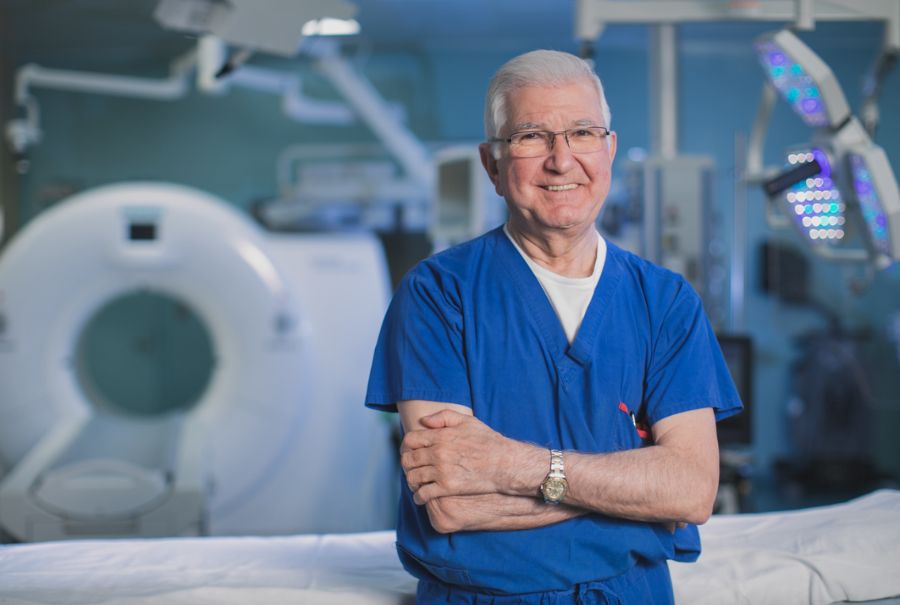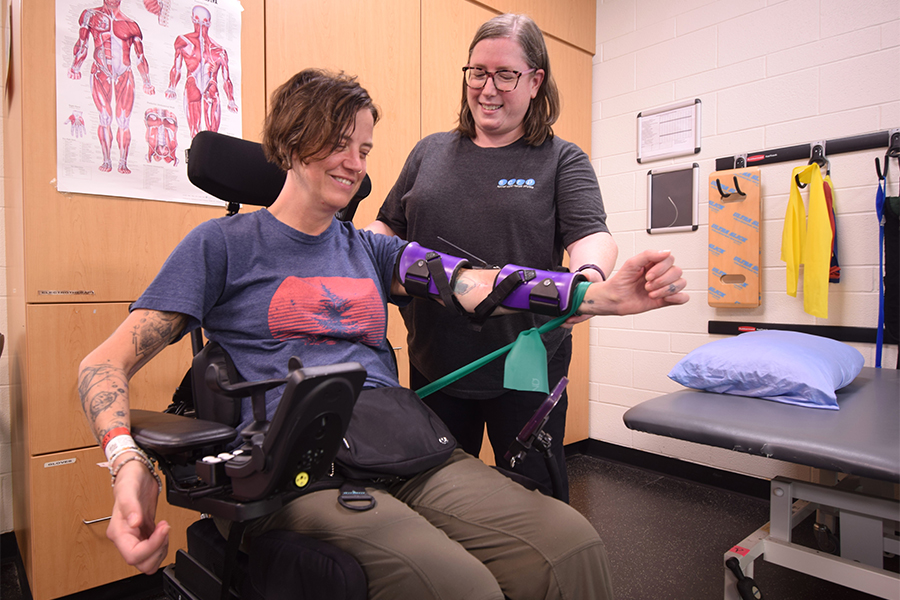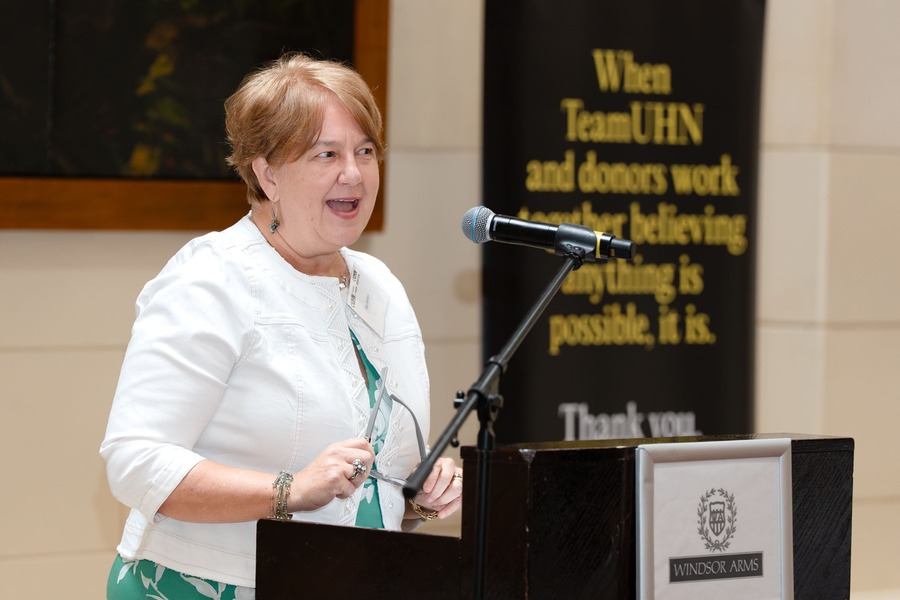Kathy Bates, Nurse Manager in the Emergency Department at Toronto Western Hospital, says the team regularly discusses the mental strain of working on the frontline in the pandemic. “What we’re living is real and we’re here to support each other,” she says. (Photo: UHN)
Kathy Bates is already more than two hours into her work day when she arrives at her office in the Toronto Western Hospital Emergency Department (ED) just after 7 a.m.
Before making the 20-minute drive to work, Kathy, Nurse Manager of the TWH ED, has read any emails that arrived as she slept, reviewed the report from the overnight administrator on site, and spoken by phone to the charge nurse and ward clerks to discuss the night shift and learn of any safety concerns.
After changing into a pair of blue UHN scrubs, tying her blond hair back and putting on goggles and a level 3 surgical mask, Kathy walks through the double doors and into the bustling ED. Even before her first meeting, which is with Charge Nurse Chai Shi Yee, whose 12-hour shift ends at 7:30 a.m., Kathy knows the priority is finding beds upstairs for 13 patients – four COVID-19 positive, three more suspected – admitted overnight.
“It’s a marathon everyday,” says Kathy, a registered nurse at UHN since 1998, who has worked for more than 20 years in the TWH ED and been the Manager since 2015.
“The ED doesn’t sleep. It’s like daytime all the time.”
“And, what’s adding to the challenge is the lack of available beds.”
Triage. Treat. Transfer. That’s the rhythm of each day for Kathy and her team of about 200 nurses, clerks and patient care assistants. They, along with physicians, allied health professionals, administrative and support staff, and UHN Security personnel, have seen more than 900 patients arrive by ambulance in the previous three weeks alone. Many others have come to the ED by taxi, in the family car and on foot.
It’s always been busy here. The care needs range from ankle sprains and bone breaks, addiction and mental health, to stroke and cardiac arrests. Now, in the depth of the third wave, the uncertainty grows with each day. Finding space to treat those admitted is tougher as the number of COVID patients upstairs rises.
“People are sicker now when they come in,” Kathy says. “That means the workload on everyone is heavier because of all the precautions we have to take to keep everyone safe.
At the Sub-Acute Nursing Station in the middle of the room, Chai gives Kathy details on each of the 13 new admissions. A patient, mid-40s, is suspected of having COVID pneumonia. An older man is delirious and at risk of falling, “and they think that COVID may be causing it,” Chai says. And on it goes.
As Chai’s report continues against the backdrop of continuous motion and the din of ringing phones, beeping monitors and calls over the intercom, Kathy is in full multi-task mode: she uses her cell phone to call a COVID unit upstairs and warn more patients are coming; turns to one of two Patient Care Coordinators to confirm all precautions are in place to isolate the COVID patients and those suspected of being positive; and flags down a colleague from Stores to ask for a burned out lightbulb to be replaced.
With the day’s first meeting complete and the next one – to discuss bed capacity at the hospital – still nearly 30 minutes away, Kathy sets off on a familiar circuit. She walks the ED, from the front doors through triage, acute, sub-acute and fast-track or ambulatory, doling out a smile and casual “good morning” to some, a more concerned “how are you doing today?” or “how you feeling?” to others.
“I check on how they are as people first,” Kathy says when back at her desk getting ready for the next meeting on MS Teams. “What we’re living is real and we’re here to support each other.”
Kathy pauses when asked if she’s afraid as the third wave drags on.
“I don’t have time for fear right now,” she says. “Fear is very real for all of us, and I have my moments when I wonder when this is ever going to end. And then, I shake it off and realize I’m a leader with a team to lead, and a wonderful organization supporting me, and I know we’re going to get through this.”
Just before 8:30 a.m., Kathy joins the TWH Patient Flow meeting with managers from all inpatient units, including two COVID units. In less than 10 minutes, each member of the group has sized up how the day ahead looks, confirming nine of the 13 ED admissions will be moved upstairs by noon.
“Great teamwork, right?” Kathy says after disconnecting the call.
At 9 a.m., ED team members not busy with patients gather for the daily safety huddle. Kathy reminds everyone to socially distance around the large Nursing Station. After looking back and looking forward with any safety concerns, each says what they’re grateful for. There’s appreciation for the weather, for colleagues, for an upcoming weekend off. Kathy is thankful for “the courage each of you show.”
“Be kind to each other. Be kind to yourself,” she says in winding down the huddle. “Watch out for your physical and mental health – you need your sleep and your nutrition. Make sure you take time for yourself.
“If you’re feeling fear, we all get it. It’s okay to not be okay but talk about it, support each other.”

Taking a longer route through the ED back to her office for the next meeting, Kathy reflexively reminds one colleague to put on her goggles and notes to another his mask has slipped below his nose.
“When you have no control over a large number of factors in this pandemic, you control what you can and follow what you know,” she says of her vigilance on masks, goggles and other personal protective equipment, handwashing, social distancing and not sharing food. “If we follow these basics, that’s how we protect ourselves, each other and our families in order to keep doing the job we do well everyday.”
Throughout the day, Kathy attends a host of virtual meetings. There’s a UHN-wide safety huddle and a clinical update. She talks with a community partner about finding short-term housing for a senior patient who lives alone, and discusses ED admissions from the TWH COVID-19 Assessment Centre. In between, she and colleague Jason Dickson tour a new fast track area of the ED under construction.
All the while, a steady drumbeat of ambulances continues arriving at the front doors of the ED.
“It’s not like we stop people from coming in for other things because we’re in a pandemic,” says Jason, Administrative Support Supervisor in the ED and Admitting at TWH. “So, it’s even more important for us to collaborate with our flow teams to manage our volumes and be ready for any contingency.”
Just outside his office, a large cart wrapped in plastic contains all the supplies needed to run a makeshift Surge Area in the nearby Fracture Clinic if third wave volumes require it.
“In the ED, you have to prepare for the worst and hope for the best,” Kathy says.
By 4:15 p.m., the other four patients admitted overnight will be on their way upstairs. And, although the parade of ambulances to the ED front doors has been steady, no one else is awaiting a move elsewhere.
“It’s been a good day,” says Kathy, who will leave the hospital before 6 p.m., stay in email contact with the ED until bedtime and have her phone at the ready in case she’s needed through the night.
Things can change quickly at the ED, especially right now. Two days earlier, there were 26 admissions when she arrived at her office. Tomorrow could have a similar number of patients, or even more.
“We’re in a pandemic. We have to be ready for anything,” Kathy says. “But we know we’re not alone.
“We support each other across the entire organization to get patients where they need to be. It’s teamwork.”


